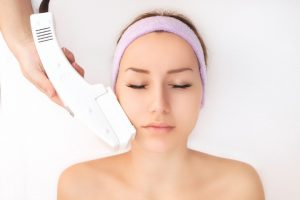“Skin rejuvenation” & “skin resurfacing” are frequently used terms in the world of aesthetic improvement, often being uttered interchangeably. However, these terms have slightly (though importantly) different meanings. “Skin rejuvenation” is a more general term that refers to any products and/or treatments intended to improve the appearance of the skin, whereas “skin resurfacing” describes a specific treatment where the damaged layer of the skin is removed. All skin resurfacing is a type of skin rejuvenation, but not all skin rejuvenation is skin resurfacing—somewhat like the difference between rectangles & squares.
 There are countless types of skin rejuvenation, all designed to treat specific aesthetic concerns about the skin. Many over-the-counter topical skin regimes and self-administered treatments can superficially improve the appearance of the skin, but more powerful solutions are available to be prescribed or performed under the supervision of a medical professional. For instance, topical agents such as Retin-A® and hydroquinone improve the quality of the skin slowly over a period of 6 to 12 months, whereas other methods (like facial peels) have more immediate results.
There are countless types of skin rejuvenation, all designed to treat specific aesthetic concerns about the skin. Many over-the-counter topical skin regimes and self-administered treatments can superficially improve the appearance of the skin, but more powerful solutions are available to be prescribed or performed under the supervision of a medical professional. For instance, topical agents such as Retin-A® and hydroquinone improve the quality of the skin slowly over a period of 6 to 12 months, whereas other methods (like facial peels) have more immediate results.
Chemical peels) are extremely effective forms of skin resurfacing, usually utilizing acids to remove the very top layer of a patient’s skin. These treatments can reduce the appearance of fine lines and improve discoloration. Some chemical peels are administered in a series of several treatments over time, whereas others require only one session. For instance, facial peels that use a topical application of trichloroacetic acid (TCA), either as a single treatment or in combination with facial plastic surgery, can more immediately improve skin quality & texture than long-term agents.
As effective as chemical peels can be, techniques that utilize lasers are considered to be among the most effective skin treatments available. Laser skin resurfacing (like Sciton® ablative & non-ablative) can powerfully remedy uneven pigmentation, wrinkles, & enlarged pores using a calibration that removes of the outer layer of skin. Laser skin resurfacing results in a rejuvenated, refreshed appearance that no other procedure can quite match. For tens of thousands of people every year, laser skin resurfacing repairs discoloration, wrinkles, uneven skin tone & texture, skin consistency, blotches, blemishes, and more. People who undergo laser skin resurfacing are often surprised at how radiant & refreshed they look after their treatment. As is the case with many cosmetic procedures, it’s difficult to understand how much of a difference this relatively easy procedure can make until you see it for yourself.
If you’re interested in improving the look of your skin, or if you’d like to learn about the many procedures I perform, contact me, Dr. Jim Namnoum, to schedule a consultation. Don’t forget to connect with me on Facebook, Twitter, & Instagram, and come back to the blog soon for more advice and information on looking your best.

